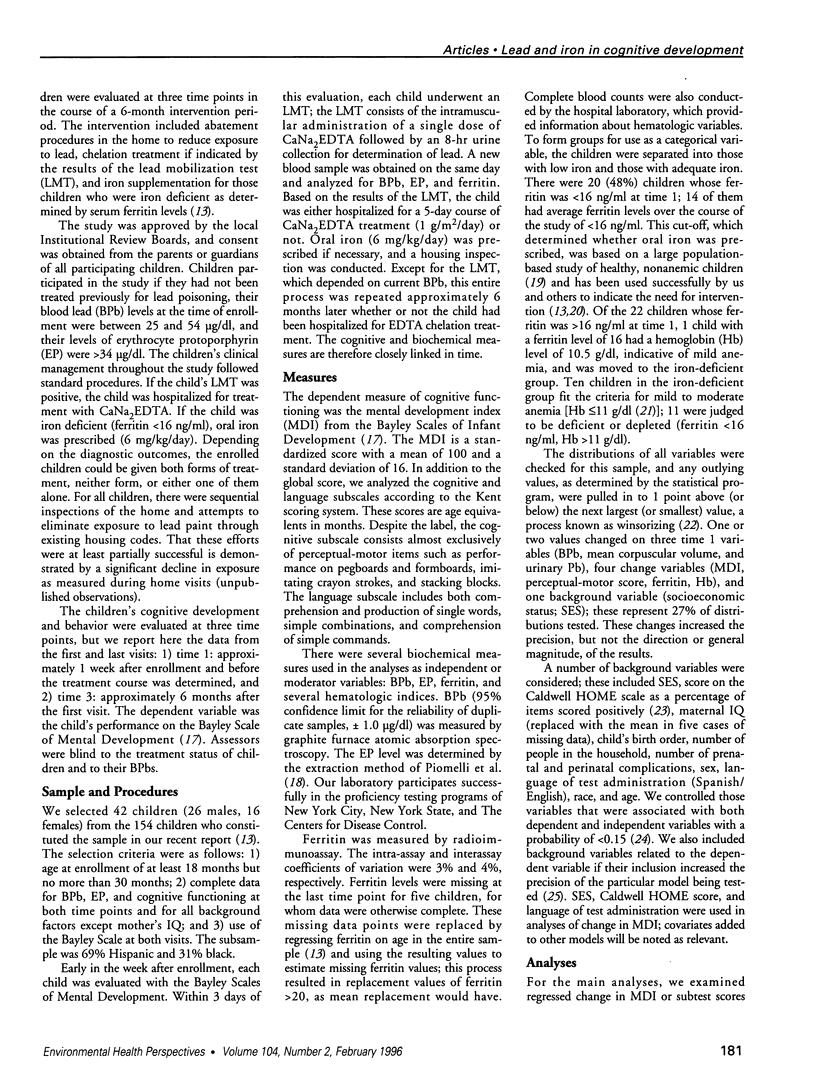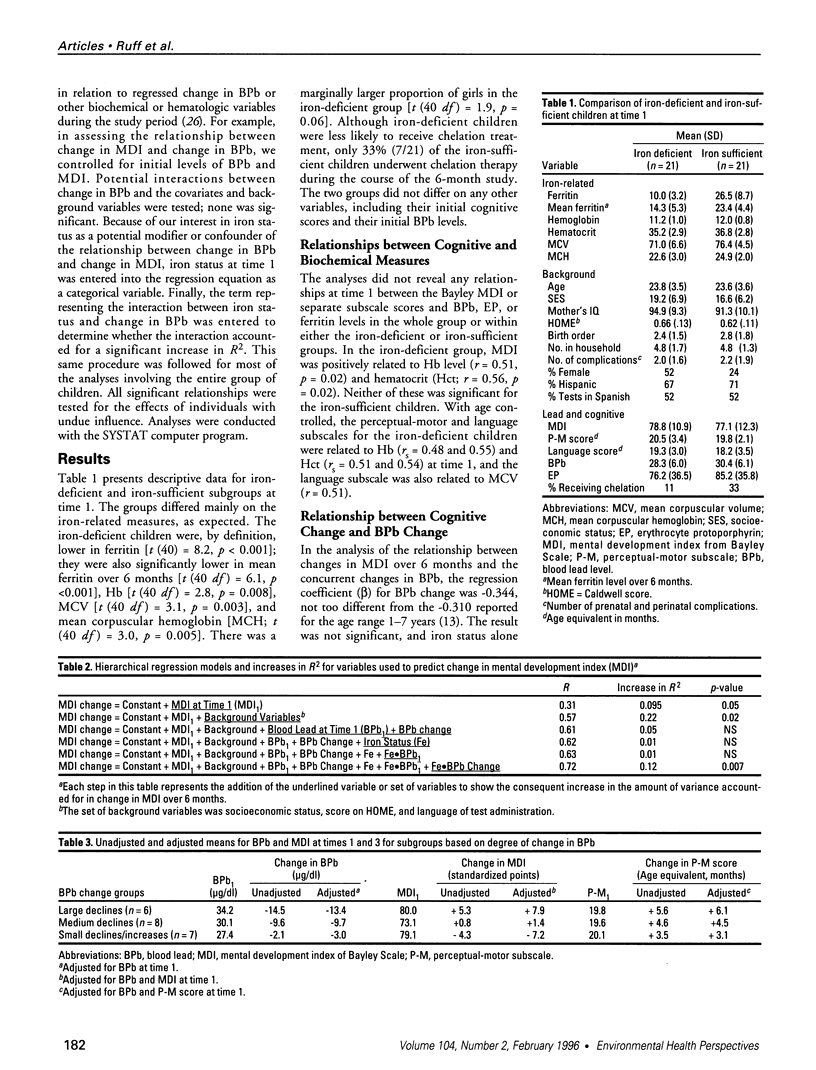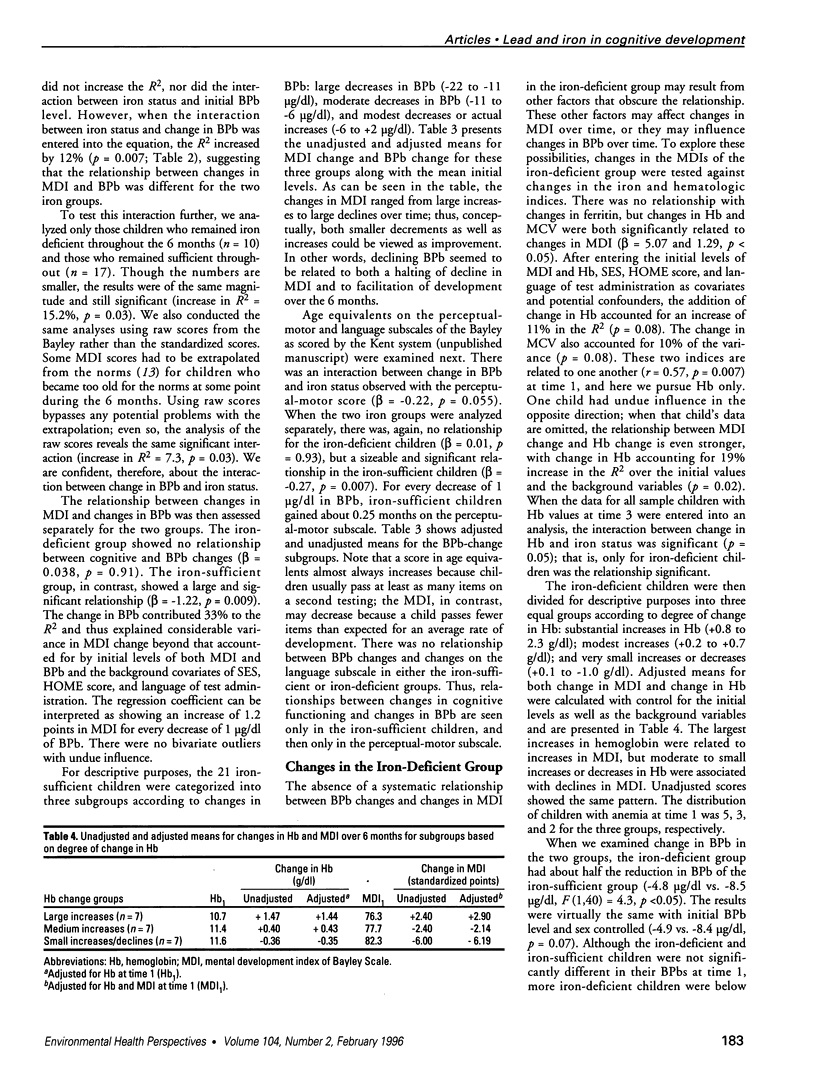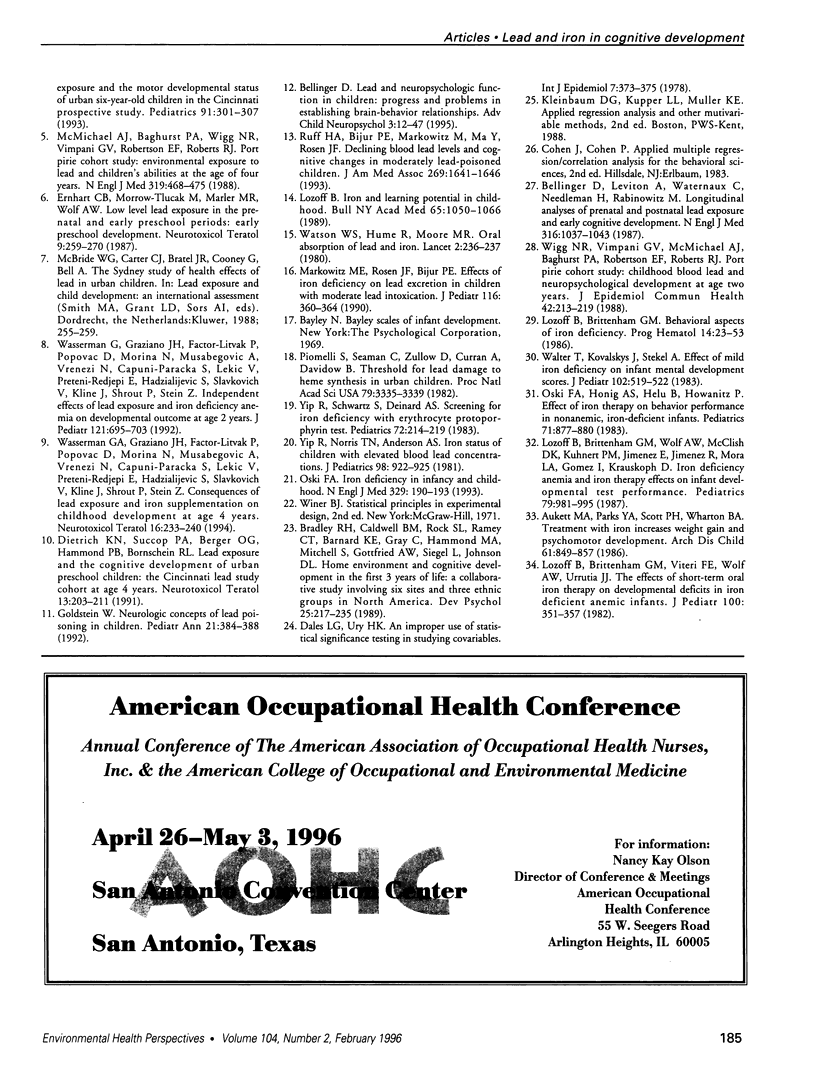Abstract
The goals of this study were to explore the relationship of declining blood lead levels and cognitive development in 42 moderately lead poisoned children around 2 years of age and to investigate the potential interaction between iron and lead levels in the course of development. The cognitive functioning of children was assessed upon enrollment into a comprehensive intervention and 6 months later. The intervention consisted of chelation treatment, if appropriate, iron supplementation, if needed, and steps to eliminate the source of lead in the home environment. The children were referred because of blood lead levels between 25 and 55 mu g/dl; they were also selected on the basis of age between 18 and 30 months. The outcome measures were the global score on a standardized test of cognitive development and subscale scores for perceptual-motor and language functioning. Cognitive change over 6 months was related to an interaction between change in blood lead and initial iron status. Specifically, the change in standardized score (particularly change in perceptual-motor performance) was strongly related to change in blood lead in children who were iron sufficient at the outset: there was an increase of 1.2 points for every 1 mu g/dl decrease in blood lead. There was no such relationship in iron-deficient children. Secondary analyses suggested that 1) the change in cognitive functioning of iron-deficient children was related to change in hemoglobin, and 2) the decline in blood lead was less in iron-deficient than in iron-sufficient children. Thus, when iron is sufficient, changes in blood lead and changes in cognition are inversely related. When iron is deficient, other processes affect the outcome.
Full text
PDF





Selected References
These references are in PubMed. This may not be the complete list of references from this article.
- Aukett M. A., Parks Y. A., Scott P. H., Wharton B. A. Treatment with iron increases weight gain and psychomotor development. Arch Dis Child. 1986 Sep;61(9):849–857. doi: 10.1136/adc.61.9.849. [DOI] [PMC free article] [PubMed] [Google Scholar]
- Baghurst P. A., McMichael A. J., Wigg N. R., Vimpani G. V., Robertson E. F., Roberts R. J., Tong S. L. Environmental exposure to lead and children's intelligence at the age of seven years. The Port Pirie Cohort Study. N Engl J Med. 1992 Oct 29;327(18):1279–1284. doi: 10.1056/NEJM199210293271805. [DOI] [PubMed] [Google Scholar]
- Bellinger D. C., Stiles K. M., Needleman H. L. Low-level lead exposure, intelligence and academic achievement: a long-term follow-up study. Pediatrics. 1992 Dec;90(6):855–861. [PubMed] [Google Scholar]
- Bellinger D., Leviton A., Waternaux C., Needleman H., Rabinowitz M. Longitudinal analyses of prenatal and postnatal lead exposure and early cognitive development. N Engl J Med. 1987 Apr 23;316(17):1037–1043. doi: 10.1056/NEJM198704233161701. [DOI] [PubMed] [Google Scholar]
- Bellinger D., Sloman J., Leviton A., Rabinowitz M., Needleman H. L., Waternaux C. Low-level lead exposure and children's cognitive function in the preschool years. Pediatrics. 1991 Feb;87(2):219–227. [PubMed] [Google Scholar]
- Dales L. G., Ury H. K. An improper use of statistical significance testing in studying covariables. Int J Epidemiol. 1978 Dec;7(4):373–375. doi: 10.1093/ije/7.4.373. [DOI] [PubMed] [Google Scholar]
- Dietrich K. N., Berger O. G., Succop P. A. Lead exposure and the motor developmental status of urban six-year-old children in the Cincinnati Prospective Study. Pediatrics. 1993 Feb;91(2):301–307. [PubMed] [Google Scholar]
- Dietrich K. N., Succop P. A., Berger O. G., Hammond P. B., Bornschein R. L. Lead exposure and the cognitive development of urban preschool children: the Cincinnati Lead Study cohort at age 4 years. Neurotoxicol Teratol. 1991 Mar-Apr;13(2):203–211. doi: 10.1016/0892-0362(91)90012-l. [DOI] [PubMed] [Google Scholar]
- Ernhart C. B., Morrow-Tlucak M., Marler M. R., Wolf A. W. Low level lead exposure in the prenatal and early preschool periods: early preschool development. Neurotoxicol Teratol. 1987 May-Jun;9(3):259–270. doi: 10.1016/0892-0362(87)90011-0. [DOI] [PubMed] [Google Scholar]
- Goldstein G. W. Neurologic concepts of lead poisoning in children. Pediatr Ann. 1992 Jun;21(6):384–388. doi: 10.3928/0090-4481-19920601-11. [DOI] [PubMed] [Google Scholar]
- Lozoff B., Brittenham G. M. Behavioral aspects of iron deficiency. Prog Hematol. 1986;14:23–53. [PubMed] [Google Scholar]
- Lozoff B., Brittenham G. M., Viteri F. E., Wolf A. W., Urrutia J. J. The effects of short-term oral iron therapy on developmental deficits in iron-deficient anemic infants. J Pediatr. 1982 Mar;100(3):351–357. doi: 10.1016/s0022-3476(82)80428-9. [DOI] [PubMed] [Google Scholar]
- Lozoff B., Brittenham G. M., Wolf A. W., McClish D. K., Kuhnert P. M., Jimenez E., Jimenez R., Mora L. A., Gomez I., Krauskoph D. Iron deficiency anemia and iron therapy effects on infant developmental test performance. Pediatrics. 1987 Jun;79(6):981–995. [PubMed] [Google Scholar]
- Lozoff B. Iron and learning potential in childhood. Bull N Y Acad Med. 1989 Dec;65(10):1050–1088. [PMC free article] [PubMed] [Google Scholar]
- Markowitz M. E., Rosen J. F., Bijur P. E. Effects of iron deficiency on lead excretion in children with moderate lead intoxication. J Pediatr. 1990 Mar;116(3):360–364. doi: 10.1016/s0022-3476(05)82821-5. [DOI] [PubMed] [Google Scholar]
- McMichael A. J., Baghurst P. A., Wigg N. R., Vimpani G. V., Robertson E. F., Roberts R. J. Port Pirie Cohort Study: environmental exposure to lead and children's abilities at the age of four years. N Engl J Med. 1988 Aug 25;319(8):468–475. doi: 10.1056/NEJM198808253190803. [DOI] [PubMed] [Google Scholar]
- Oski F. A., Honig A. S., Helu B., Howanitz P. Effect of iron therapy on behavior performance in nonanemic, iron-deficient infants. Pediatrics. 1983 Jun;71(6):877–880. [PubMed] [Google Scholar]
- Oski F. A. Iron deficiency in infancy and childhood. N Engl J Med. 1993 Jul 15;329(3):190–193. doi: 10.1056/NEJM199307153290308. [DOI] [PubMed] [Google Scholar]
- Piomelli S., Seaman C., Zullow D., Curran A., Davidow B. Threshold for lead damage to heme synthesis in urban children. Proc Natl Acad Sci U S A. 1982 May;79(10):3335–3339. doi: 10.1073/pnas.79.10.3335. [DOI] [PMC free article] [PubMed] [Google Scholar]
- Ruff H. A., Bijur P. E., Markowitz M., Ma Y. C., Rosen J. F. Declining blood lead levels and cognitive changes in moderately lead-poisoned children. JAMA. 1993 Apr 7;269(13):1641–1646. [PubMed] [Google Scholar]
- Walter T., Kovalskys J., Stekel A. Effect of mild iron deficiency on infant mental development scores. J Pediatr. 1983 Apr;102(4):519–522. doi: 10.1016/s0022-3476(83)80177-2. [DOI] [PubMed] [Google Scholar]
- Wasserman G. A., Graziano J. H., Factor-Litvak P., Popovac D., Morina N., Musabegovic A., Vrenezi N., Capuni-Paracka S., Lekic V., Preteni-Redjepi E. Consequences of lead exposure and iron supplementation on childhood development at age 4 years. Neurotoxicol Teratol. 1994 May-Jun;16(3):233–240. doi: 10.1016/0892-0362(94)90044-2. [DOI] [PubMed] [Google Scholar]
- Wasserman G., Graziano J. H., Factor-Litvak P., Popovac D., Morina N., Musabegovic A., Vrenezi N., Capuni-Paracka S., Lekic V., Preteni-Redjepi E. Independent effects of lead exposure and iron deficiency anemia on developmental outcome at age 2 years. J Pediatr. 1992 Nov;121(5 Pt 1):695–703. doi: 10.1016/s0022-3476(05)81895-5. [DOI] [PubMed] [Google Scholar]
- Watson W. S., Hume R., Moore M. R. Oral absorption of lead and iron. Lancet. 1980 Aug 2;2(8188):236–237. doi: 10.1016/s0140-6736(80)90124-5. [DOI] [PubMed] [Google Scholar]
- Wigg N. R., Vimpani G. V., McMichael A. J., Baghurst P. A., Robertson E. F., Roberts R. J. Port Pirie Cohort study: childhood blood lead and neuropsychological development at age two years. J Epidemiol Community Health. 1988 Sep;42(3):213–219. doi: 10.1136/jech.42.3.213. [DOI] [PMC free article] [PubMed] [Google Scholar]
- Yip R., Norris T. N., Anderson A. S. Iron status of children with elevated blood lead concentrations. J Pediatr. 1981 Jun;98(6):922–925. doi: 10.1016/s0022-3476(81)80589-6. [DOI] [PubMed] [Google Scholar]
- Yip R., Schwartz S., Deinard A. S. Screening for iron deficiency with the erythrocyte protoporphyrin test. Pediatrics. 1983 Aug;72(2):214–219. [PubMed] [Google Scholar]


